Cordyceps mushrooms, a fascinating and valuable species, hold immense potential for profitable cultivation. Exploring their growth’s intricate techniques and practices can unveil opportunities. This guide delves into the scientific intricacies of cultivating Cordyceps mushrooms, offering precise insights and methods that can yield significant profits. By mastering the art of Cordyceps cultivation, enthusiasts and entrepreneurs can tap into a market driven by traditional herbal uses and modern wellness trends.
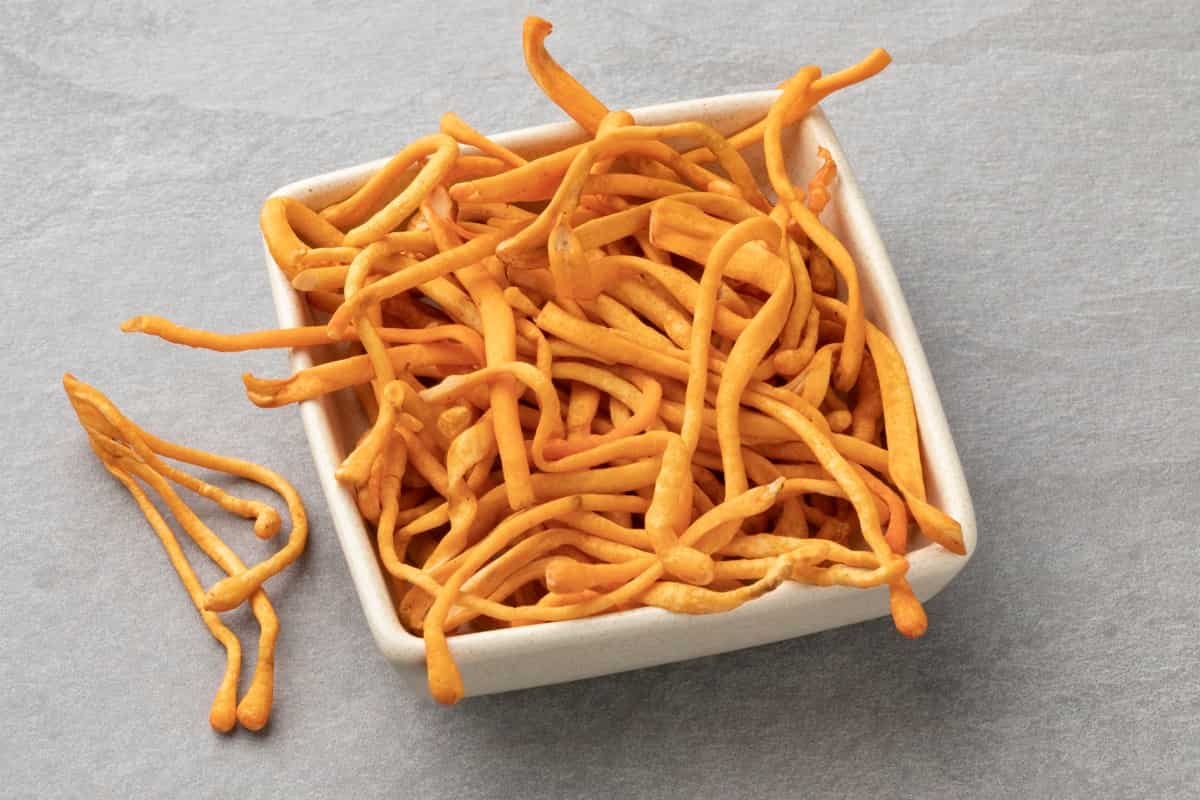
How to Grow Cordyceps Mushrooms
What are Cordyceps Mushrooms?
For centuries, Cordyceps mushrooms, integral to Traditional Chinese Medicine, offer various health advantages. Historically employed to address conditions such as kidney and lung ailments, heart issues, and even cancer, these mushrooms have a storied past. In modern times, their potential to enhance athletic performance, augment energy levels, fortify the immune system, and alleviate diabetic conditions is recognized.
Ongoing scientific exploration continues to unveil the therapeutic potential of cordyceps, aligning with traditional wisdom. In Sikkim, India, healers advocate for cordyceps sinensis as a comprehensive tonic, attributing it to improved energy, appetite, stamina, libido, endurance, and sleep patterns.
Understanding the Basics of Cordyceps Mushrooms
Cordyceps mushrooms, prominent globally, thrive mainly in Asian temperate regions, often growing on deceased insects or animals, drawing sustenance from decomposition. Revered in traditional Chinese medicine, they’re a common ingredient in supplements and herbal remedies. These mushrooms, laden with immunostimulatory, anti-inflammatory, and anti-tumor properties, bolster the immune system, combat inflammation, and shield against cancer.
Additionally, they enhance athletic performance, boosting cardiovascular fitness and oxygen uptake. Cordyceps mushrooms offer a natural health boost, but consulting a medical before incorporating them into your routine is advisable, as with any supplement. These fungi embody a rich history and a diverse range of potential benefits.
Choosing the Right Growing Medium for Cordyceps Mushrooms
In Fungi Ally, five Cordyceps strains were cultivated: WPB, 2NB1, RUP, Shanghai, and 003. Non-U.S. strains excelled due to their development for high yield, with Shanghai and Indian strains proving the most fruitful. The average yield per jar from the Shanghai strain was 11.6 grams. Cordyceps cultivation involves strain selection, media preparation using a specific recipe, and inoculation using petri plate wedges.
In case you missed it: Mushroom Farming Business Plan: Investment, Profit, and Cultivation Steps
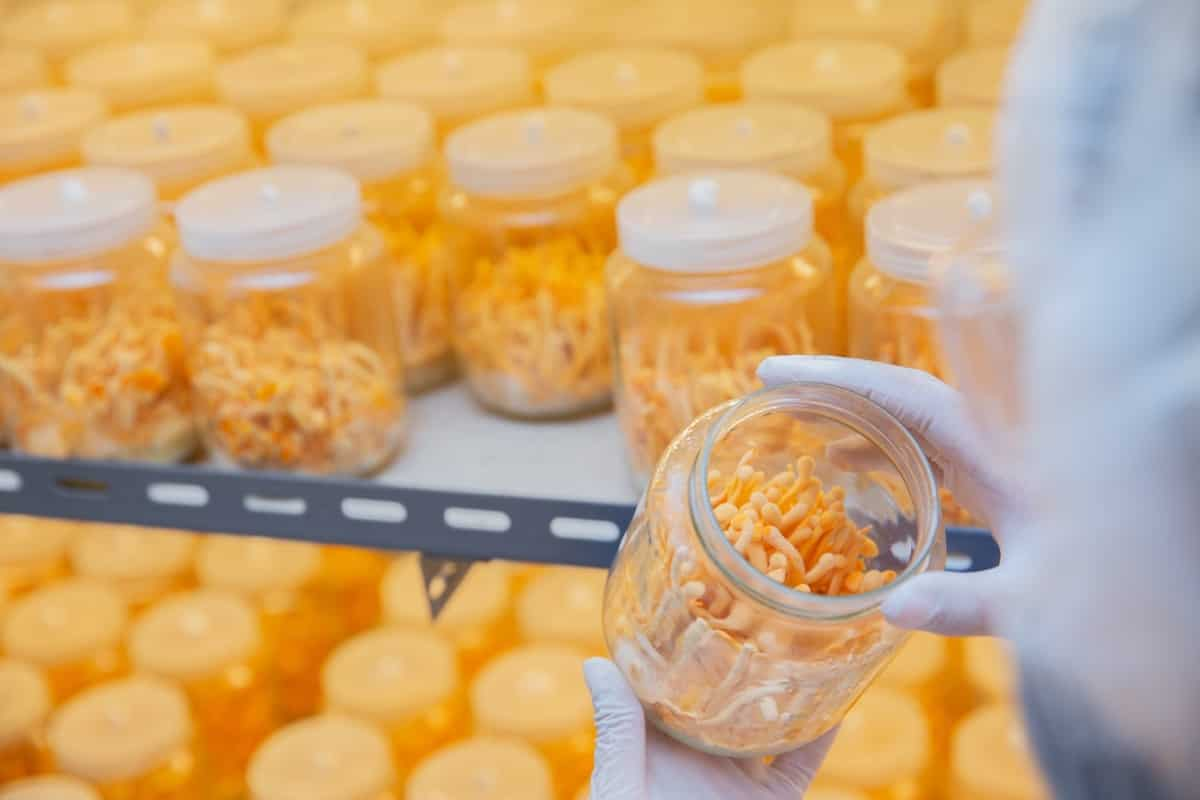
The media recipe includes water, starch, nutritional yeast, sugar, azomite, and baby food. Inoculation is done with petri plate slices in a sterilized environment. Successful cultivation hinges on strain choice, precise media preparation, and controlled inoculation for optimal yields.
Materials and Equipment for Growing Cordyceps Mushrooms
Materials
- Cordyceps Liquid Culture: The foundation for cultivating the fungus.
- Substrate – Brown Rice: The nourishing medium where Cordyceps will thrive.
- Nutrient Broth: Providing essential nutrients for growth.
- Sugar and Starch: Vital energy sources for the fungus.
- Nutritional Yeast: Contributing to fungal development.
- Trace Minerals: Ensuring a balanced nutritional environment.
- Pureed Baby Food or Vegetables: Additional nourishment.
- Filtered Water: The lifeblood of the culture.
Equipment
- Wide-Mouth Mason Jars: Homes for the culture.
- Face Mask: Maintaining a sterile environment.
- Isopropyl Alcohol: Keeping things germ-free.
- Gloves: Protecting both you and the culture.
- Polyfill (Similar to Pillow Stuffing): Allowing gas exchange while keeping contaminants at bay.
The cordyceps liquid culture is the most important ingredient, containing the fungus spores. The substrate provides the nutrients that the fungus needs to grow. The nutrient broth, sugar, and starch are all sources of nutrients. Nutritional yeast and trace minerals provide additional nutrients. Pureed baby food or vegetables provide a source of moisture. Filtered water helps to prevent contamination.
The wide-mouth mason jars are used to grow mushrooms. The face mask, isopropyl alcohol, and gloves prevent contamination. The polyfill is used to create a filter on the lids of mason jars. The specific steps in growing cordyceps mushrooms can vary depending on your chosen method.
- Mix the substrate with the nutrient broth, sugar, starch, nutritional yeast, trace minerals, and pureed baby food or vegetables.
- Sterilize the mason jars and lids in a pressure cooker.
- Inoculate the jars with the cordyceps liquid culture.
- Incubate the jars in a dark, warm place.
- Harvest the mushrooms when they are mature.
Creating an Optimal Growing Environment for Cordyceps Mushrooms
- Temperature: Cordyceps mushrooms grow best in a warm environment, with an ideal temperature of 70-80 degrees Fahrenheit.
- Humidity: Cordyceps mushrooms also need high humidity, with a relative humidity of 70-80%.
- Light: Cordyceps mushrooms do not need light to grow, but they can benefit from some indirect light.
- Oxygen: Cordyceps mushrooms need good air circulation to prevent mold and contamination.
- Substrate: Cordyceps mushrooms can be grown on various substrates, but brown rice is a good option.
- Spores: Cordyceps mushrooms can be grown from spores or a liquid culture.
In case you missed it: How this Farmer Earning 60 Thousand Rupees from Milky Mushroom Farm at Home
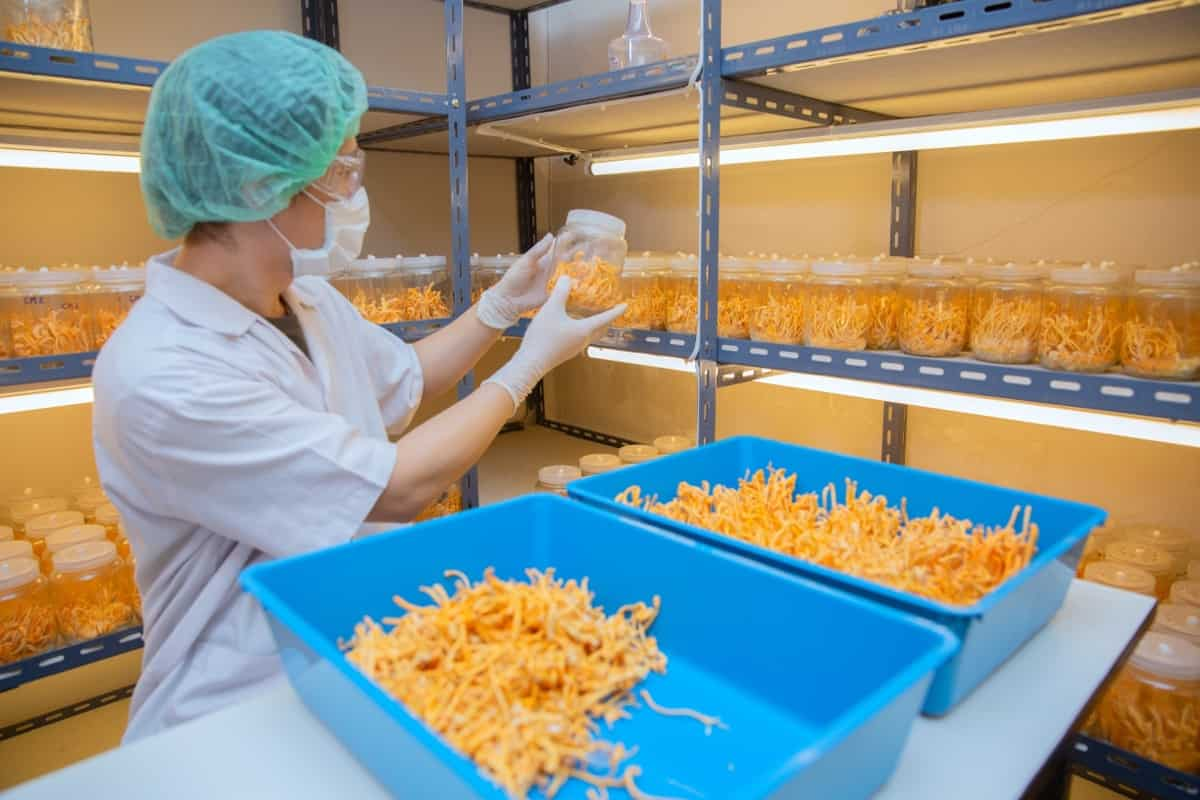
Selecting the Best Cordyceps Mushroom Strain for Cultivation
Ggrow Cordyceps tn Jars and Bins
- Create a nutrient broth using coconut water, tapioca starch, magnesium sulfate, multivitamins (crushed), nutritional yeast or soy peptone, kelp powder, and gypsum.
- Mix the ingredients in a bowl and add coconut water.
- Store extra broth in the fridge for up to one week.
Drill holes in lids for jar cultivation and create a filter with Poly-fil. Combine 46 milliliters of nutrient broth with 28 grams of brown rice for each jar and add them to a pressure cooker. Incubate the jars by introducing 1-2 milliliters of liquid culture through the Poly-fil and sterilizing the needle between each addition. Combine 855 grams of rice with 1 liter of nutrient broth to the Instant Pot insert for bin cultivation.
Proper measurement of both is vital for appropriate saturation and limiting bacterial growth. Place the insert into the Instant Pot and run it on the rice setting. Inoculating bins involves allowing the rice and nutrient broth mixture to cool to room temperature before introducing the liquid culture. Sterilize the mixing spoon and allow it to dry before use.
Use a flow hood or glove box for best results. Mix 120-300 milliliters of liquid culture to the substrate mixture and layer a half inch of mixture along the bottom of the bin. Keep the bin sealed well with minimal airflow, using lid clips or parafilm around the lid. Consider adding filter patches if your bin has a rubber or airtight seal.
Sourcing High-quality Cordyceps Mushroom Spawn or Culture
Create the growing media: The growing media is a mixture of nutrient broth and grain, usually rice. The nutrient broth provides the fungus with vitamins, carbon, and nitrogen, while the grain provides a source of carbohydrates. To create the nutrient broth, combine 4.5L of water, 1/2 cup of starch, 1/4 cup of nutritional yeast, 2 tbsp of sugar, 2 tbsp of organic trace mineral powder, and five scoops of organic baby food or pureed vegetables in a pot. Bring the mixture to boil, then reduce heat and simmer for 15 minutes. Allow the mixture to cool before using.
Inoculate the media: Add 2 tbsp of rice to each mason jar once the nutrient broth has cooled. Then, add ¼ cup of the nutrient broth to each jar. Screw the lids of jars tightly to sterilize them in a pressure cooker for 3 hours at 120° C. Allow them to cool completely before inoculation.
Incubate the media: After the jars have cooled, inoculate them with cordyceps militaris liquid culture. To do this, inject the liquid culture into each jar using a sterile syringe. Be sure to inject the liquid culture evenly throughout the jar.
Pin and fruit the mushrooms: Once the jars have been inoculated, they need to be incubated in a dark place with a temperature of 12-24° C. The incubation period can take anywhere from 10 to 20 days. During this time, the fungus will colonize the media and begin to form mushrooms.
In case you missed it: How to Grow Mushrooms in Coffee Grounds at Home: Steps, Ideas, and Tips for Beginners
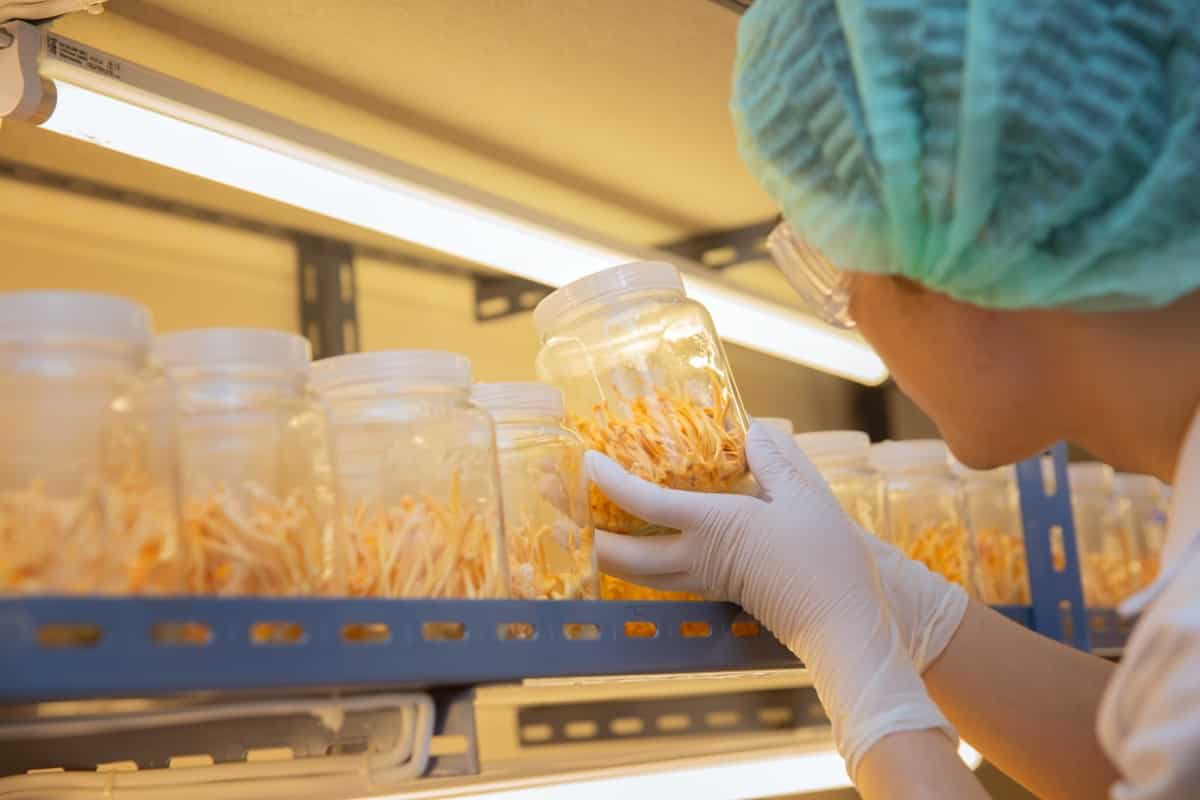
Harvest the mushrooms: Once they have matured, they can be harvested. To do this, carefully remove the mushrooms from the jars and rinse them with cold water. The mushrooms can then be dried or used fresh.
Preparing the Growing Substrate for Cordyceps Mushrooms
Cordyceps is a fungus that can be grown at home, but it can be challenging to get the hang of. The most common species of cordyceps grown at home is cordyceps militaris, which grows well on a substrate of grain and a nutrient-rich liquid. Ensuring proper sanitation during the cultivation process is important to prevent contamination.
Cordyceps sinensis, the most well-known species of cordyceps, is not vegan-friendly because it grows on insect hosts. However, cordyceps militaris is generally considered vegan-friendly because it is not grown on insect hosts. The fruiting bodies of cordyceps militaris have a savory, earthy/nutty flavor and can be eaten raw, cooked, or distilled into a liquid tincture.
Inoculating the Substrate with Cordyceps Mushroom Spawn
Cordyceps spawn is not commercially available, so researchers used wedges from fully grown petri plates to inoculate the jars. The jars were incubated under a flow hood in a positive pressure lab to filter out airborne contaminants. The cordyceps mycelium grew vigorously in the dark at 55-75 degrees Fahrenheit.
The spawn run typically took about 21 days, but some strains took longer. The petri plates were cut into eight pie slices, and one slice was placed into each jar. The jars were sealed and moved to incubation after the wedges were placed inside. The incubation temperature was 70 degrees Fahrenheit. The spawn run was complete when the mycelium had fully colonized the media.
Cordyceps Mushroom Price
Cordyceps mushrooms, valued for their potential health benefits, vary in price based on type, quality, and form. Wild-harvested Cordyceps sinensis, a rare and sought-after species, can cost thousands of dollars per kilogram due to its scarcity. Cultivated varieties like Cordyceps militaris are more accessible, with prices ranging from $25 to $95 per 100 grams, depending on quality. Extracts, capsules, and powders are also available, affecting the cost.
Managing Light Exposure for Cordyceps Mushroom Development
These fungi exhibit phototropic behavior, adjusting growth towards light sources. Daily exposure of around 15 minutes to diffused natural or artificial light is recommended during the mycelial growth phase to stimulate fruiting body formation. Subsequent darkness encourages primordia formation. Once primordia emerge, increase light exposure to promote proper elongation and development of mature fruiting bodies. Maintaining a consistent light-dark cycle aligns with the natural habitat conditions for optimal Cordyceps growth.
In case you missed it: Top 22 Steps/Ways to Boost Mushroom Yield: How to Increase Production, Quality, and Size
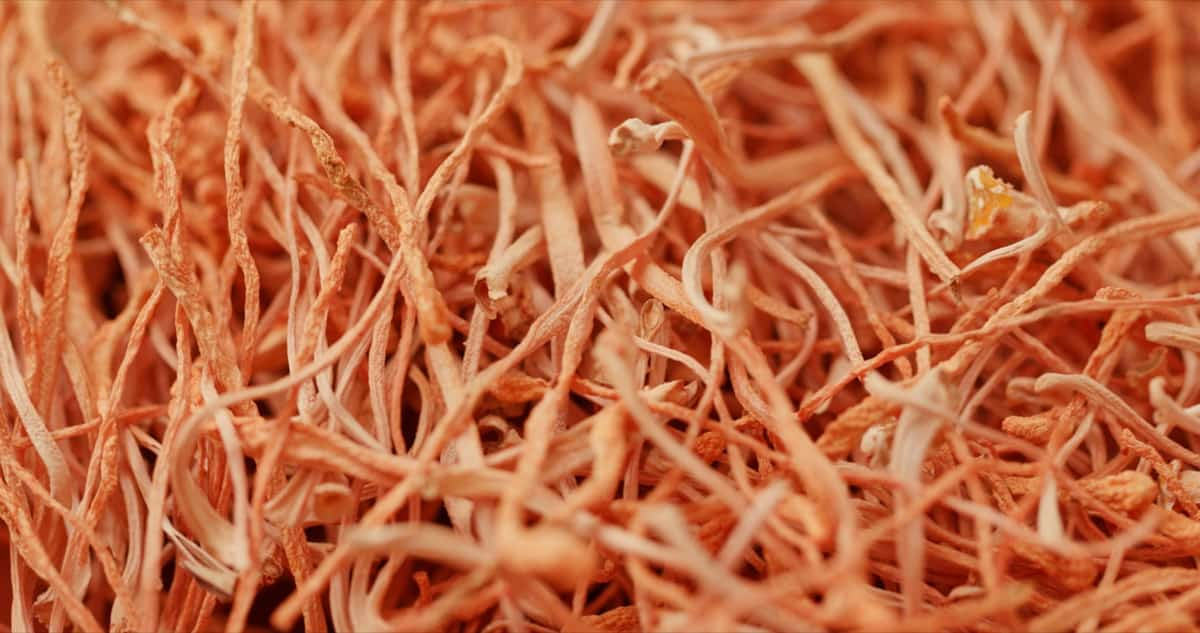
Monitoring and Adjusting Ph Levels in the Growing Medium
These fungi thrive within specific pH ranges, typically between 5.5 and 7.5. Regularly measuring the pH of the substrate helps ensure optimal nutrient availability and mycelial growth. To achieve this, use pH meters or test kits. If pH drifts beyond the desired range, corrective measures are necessary. Adding pH-adjusting substances like lime or sulfur can bring the pH back to a suitable level.
Controlling Contamination Risks in Cordyceps Mushroom Cultivation
Researchers used wedges from fully grown petri plates to inoculate jars under a flow hood in a positive pressure lab to grow Cordyceps. The jars were incubated in the dark at 70 degrees Fahrenheit for 21 days or longer for some strains. The mycelium grew vigorously during this time and fully colonized the media when the spawn run was complete.
Harvesting Cordyceps Mushrooms at the Right Time for Maximum Yield
The best time to harvest cordyceps mushrooms is when the fruiting bodies are fully developed before they dry out. This is usually when the fruiting bodies are about 1-2 inches long. They will lose nutritional value if you wait too long to harvest the mushrooms. To harvest the mushrooms, remove them from the jar and rinse them with cold water. The mushrooms can then be dried or used fresh. If you are drying the mushrooms, spread them on a baking sheet and place them in a cool, dark place. The mushrooms should be completely dry within a few days.
Storing and Preserving Cordyceps Mushrooms for Longevity
- Dry the mushrooms completely: This can be done by spreading them on a baking sheet and placing them in a cool, dark place.
- Store the dried mushrooms in a container: This will help to protect them from moisture and air, which can cause them to spoil.
- Store the mushrooms in a cool, dark place, preserving their nutrients and flavor.
In case you missed it: Hydroponic Mushroom Farming – Production, Cultivation
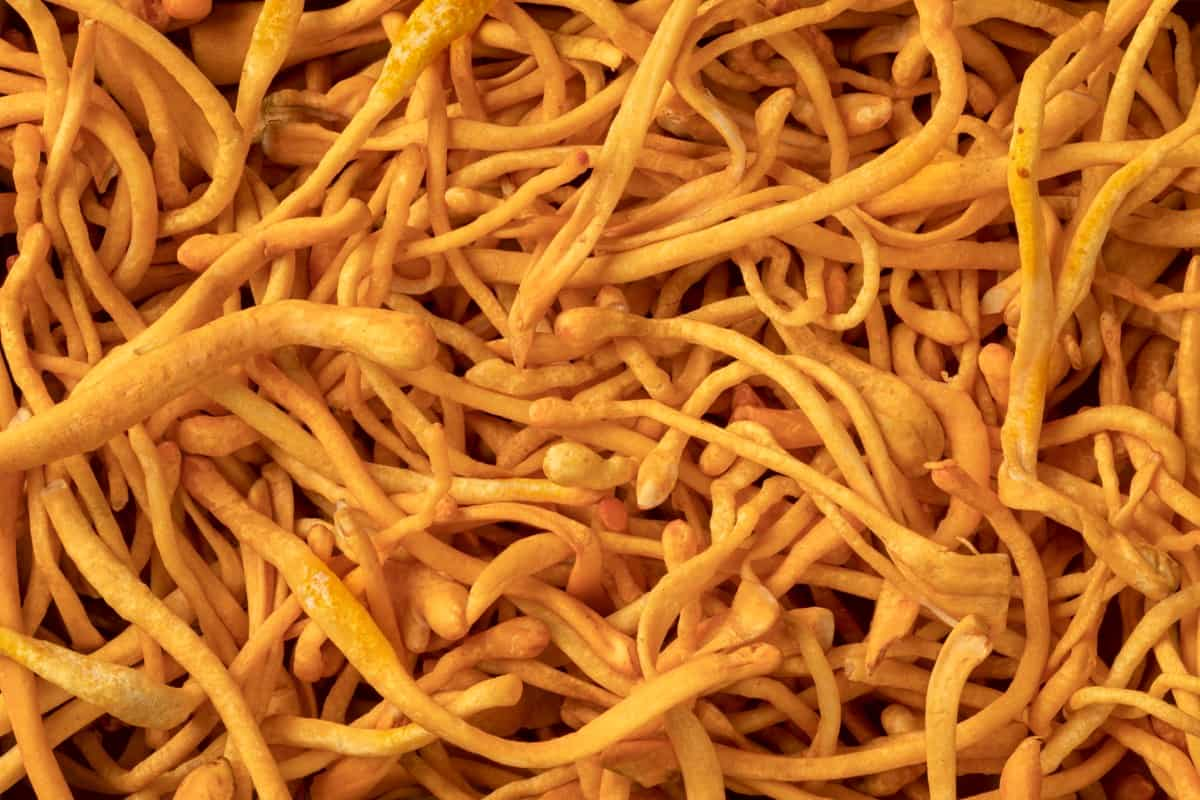
Conclusion
Successful Cordyceps mushroom cultivation is achievable by incorporating precise techniques like controlled light exposure and pH regulation. By mastering these practices, cultivators can enhance yields, ensuring a profitable venture while contributing to the thriving field of mushroom cultivation.
- Types of Pesticides Used in Agriculture: A Beginner’s Guide
- Economical Aquaculture: A Guide to Low-Budget Fish Farming
- 15 Common Planting Errors That Can Doom Your Fruit Trees
- How to Make Houseplants Bushy: Effective Tips and Ideas
- Innovative Strategies for Boosting Coconut Pollination and Yield
- Pollination Strategies for Maximum Pumpkin Yield
- The Complete Guide to Chicken Fattening: Strategies for Maximum Growth
- Natural Solutions for Tulip Problems: 100% Effective Remedies for Leaf and Bulb-Related Issues
- Revolutionizing Citrus Preservation: Towards a Healthier, Greener Future
- Natural Solutions for Peony Leaf and Flower Problems: 100% Effective Remedies
- Maximizing Profits with Avocado Contract Farming in India: A Comprehensive Guide
- Natural Solutions for Hydrangea Problems: 100% Effective Remedies for Leaf and Flowers
- The Ultimate Guide to Choosing the Perfect Foliage Friend: Bringing Life Indoors
- From Sunlight to Sustainability: 15 Ways to Use Solar Technology in Agriculture
- The Ultimate Guide to Dong Tao Chicken: Exploring from History to Raising
- The Eco-Friendly Makeover: How to Convert Your Unused Swimming Pool into a Fish Pond
- Mastering the Art of Delaware Chicken Farming: Essentials for Healthy Backyard Flocks
- 20 Best Homemade Fertilizers for Money Plant: DIY Recipes and Application Methods
- How to Craft a Comprehensive Free-Range Chicken Farming Business Plan
- Brighten Your Flock: Raising Easter Egger Chickens for Beauty and Bounty
- How to Optimize Your Poultry Egg Farm Business Plan with These Strategies
- Subsidy for Spirulina Cultivation: How Indian Government Schemes Encouraging Spirulina Farmers
- Ultimate Guide to Raising Dominique Chickens: Breeding, Feeding, Egg-Production, and Care
- Mastering the Art of Raising Jersey Giant Chickens: Care, Feeding, and More
- Ultimate Guide to Raising Legbar Chickens: Breeding, Farming Practices, Diet, Egg-Production
- How to Raise Welsummer Chickens: A Comprehensive Guide for Beginners
- How to Protect Indoor Plants in Winter: A Comprehensive Guide
- Ultimate Guide to Grow Bag Gardening: Tips, Tricks, and Planting Ideas for Urban Gardeners
- Guide to Lotus Cultivation: How to Propagate, Plant, Grow, Care, Cost, and Profit
- Agriculture Drone Subsidy Scheme: Government Kisan Subsidy, License, and How to Apply Online
- Ultimate Guide to Raising Araucana Chickens: Breed Profile, Farming Economics, Diet, and Care
- Bringing Hydroponics to Classroom: Importance, Benefits of Learning for School Students
- Ultimate Guide to Raising Polish Chickens: Breed Profile, Farming Economics, Diet, and Care
- Ultimate Guide to Raising Australorp Chickens: Profile, Farming Economics, Egg Production, Diet, and Care
- Silkie Chicken Farming: Raising Practices, Varieties, Egg Production, Diet, and Care
- Sussex Chicken Farming: Raising Practices, Varieties, Egg Production, Diet and Care
I inserted in cordyceps mushroom farming training.